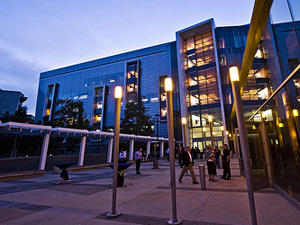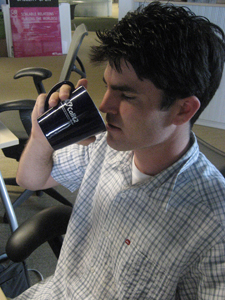Campus Energy Assessment Helps Calit2 Go Green, Save Green
By Tiffany Fox, (858) 246-0353, tfox@ucsd.edu
San Diego, CA, May 26, 2009 — It's not every day that an organization requests to be audited, but that's just what the California Institute for Telecommunications and Information Technology (Calit2) did when it invited a team of experts to assess the energy efficiency of its headquarters in Atkinson Hall.
|
Members of the UC San Diego Green Campus Program spent several hours examining the building from top to bottom, including conference rooms, staff offices, bathrooms, common areas and dining areas. They found that Calit2 already saves a significant amount of energy and water through the use of energy efficient lighting, low-flow toilets and sinks.
But there was room for improvement in several key areas: Lighting, electronics, and environmentally conscious practices such as recycling, staff education and sustainable purchasing.
"Being on the forefront of technology, we wanted to be sure we were also a campus leader in energy savings," says Calit2 Business Officer Yuki Marsden. "The information technology sector uses as much energy as the air transportation sector, and we feel it's our duty to do anything we can do to reduce that carbon footprint."
The Green Campus Program's report found that during the 2007-'08 academic year, Calit2 used an average of 518,357 kWh per month at a cost of $41,468 per month, totaling 6,220,294 kWh and $497,623 for the entire year. That amounts to more than 1 billion pounds of carbon emissions per year — or the equivalent annual carbon footprint of about 300 two-bedroom single-family homes.
The Green Campus survey calculated that Calit2 could save 5 percent of the total energy it consumes by following the suggestions provided in the energy assessment. By making simple changes like reducing overhead lighting, turning off computers and printers when not in use and educating staff about campus recycling policies, Calit2 can offset its carbon footprint by an estimated 15,000 kWh per month, at a monthly cost savings of about $1,336.
The next step for the members of Calit2's volunteer "Green Team" will be to split up into three focus groups to address the areas with the greatest potential for energy and cost savings. One group will research ways to mitigate the impacts of lighting Atkinson Hall, such as making better use of natural light or finding an alternative to the T8 florescent tubes that are currently installed in most of the building.
Calit2 Facilities Manager Tim Beach says Atkinson Hall is already equipped with several lighting features that save energy, including the Clearstory windows that line the perimeter of the building and allow natural light to permeate its interior. Calit2's reputation as a birthplace of innovation has also made it a natural "test bed" for additional energy-saving technologies UCSD is interested in implementing campus-wide, Beach points out.
"Together with members of the campus sustainability efforts, we're looking into the possibility of installing 'smart lighting' in parts of Atkinson Hall, which would allow employees to customize the lighting directly above their desks through the use of IP addresses," he explains. "We're also researching the use of LED lighting in place of fluorescent lighting, and we're looking into implementing sensors that monitor outside lighting in addition to those that monitor the indoor lighting."
|
Explains Marsden: "We have worked with the Office of Engineering Computing to make it possible for everyone to turn off their computers at night and still receive updates and system back-up. The OEC can remotely turn on computers and conduct back-ups and updates early in the morning, before people have arrived in the office."
As for printers, Marsden says the institute will "probably start looking into using the Xerox machines that we rent from campus Imprints to meet our printing needs. It's cheaper both in terms of ink and in terms of energy use."
Another volunteer group at Calit2 will look into miscellaneous sustainability practices — such as recycling, signage and procurement — that can have a significant impact on reducing the building's carbon footprint. Calit2 has taken steps in the past to encourage the "reduce, re-use, recycle" mantra: Last year, it provided 150 ceramic cups to employees in an effort to reduce paper cup waste, and the institute's Projects and Events Staff routinely makes compostable plates, cups and other party goods available to guests of Atkinson Hall. Yet there is still more work to be done: The Green Campus report suggests that Calit2 place more recycling bins in common areas, post proper signage denoting what is recyclable and encourage electronic rather than paper versions of documents.
"What's going to take us through to the next level of energy savings is to make the occupants of Atkinson Hall more aware of how they can save energy," says Beach. We've got people sitting right next to each other, and one's using a heater and the other a fan. It's just a matter of educating the building occupants to be more aware of their environment."
Adds Marsden: "With efforts like Project Greenlight, remote telepresence and numerous eco-minded events and conferences, Calit2 has a well-established tradition of supporting sustainability. But there is always more work to be done. The Green Campus report is an eye-opening document that illustrates the many ways we can all do our part to minimize waste and reduce energy consumption."
Media Contacts
Tiffany Fox, (858) 246-0353, tfox@ucsd.edu
Related Links



